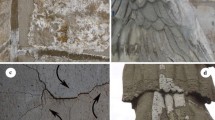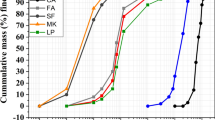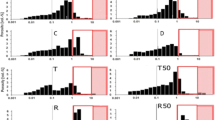Abstract
Repair mortars with different B/Ag (binder/aggregate) ratios and natural stone were studied in order to understand the influence of limestone aggregate on the properties of mortar and to check the compatibility of repair mortar with a porous limestone. Three different types of mortars with three different aggregate contents were evaluated by using mercury intrusion porosimetry (MIP) and water saturation method (WSM). Changes in density and uniaxial compressive strength as a function of aggregate content were also recorded. For comparison the properties of the porous limestone were also tested, since it is used in monuments and also as aggregate in the mortar. Tested mortars had average porosities of 27.0 % (±2.0), while oolitic limestone has higher average porosity of 32.2 % (±1.9). The limestone has mainly medium and large pore radii (1–100 μm) while the repair mortars even with high aggregate content has predominantly smaller pores. All but one pure repair mortars have higher uniaxial compressive strength than that of the oolitic limestone. The strength decreases while porosity increases with increasing aggregate content.







Similar content being viewed by others
References
Alves C, Figueiredo C, Maurício A, Braga MAS, Aires-Barros L (2011) Limestones under salt decay tests: assessment of pore network-dependent durability predictors. Environ Earth Sci 63:1511–1527
Anigrisani AC, Calcaterra D, Cappelletti P, Colella A, Parente M, Prikryl R, DeGennaro M (2011) Geological features, technological characterization and weathering phenomena of the Miocene Bryozoan and Lithothamnionlimestones (central-southern Italy). Italian J Geosci 130(1):75–92
Arizzi A, Cultrone G (2012) Aerial lime-based mortars blended with a pozzolanic additive and different admixtures: a mineralogical, textural and physical-mechanical study. Constr Build Mater 31:135–143
Arizzi A, Viles H, Cultrone G (2012) Experimental testing of the durability of lime-based mortars used for rendering historic buildings. Constr Build Mater 28:807–818
Barsottelli M, Cellai GF, Fratini F, Manganelli F (2001) The Hygrometric behaviour of some artificial stone materials used as elements of masonry walls. Mater Struct 34:211–216
Beck K, Al-Mukhtar M (2008) Formulation and characterization of an appropriate lime based mortar for use with a porous limestone. Environ Geol 56:715–727
Beck K, Al-Mukhtar M, Rozenbaum O, Rautureau M (2003) Characterization, water transfer properties and deterioration in tuffeau: building material in the Loire valley—France. Build Environ 38:1151–1162
Belfiore CM, La Russa MF, Mazzoleni P, Pezzino A, Viccaro M (2010) Technological study of “ghiara” mortars from the historical city centre of Catania (Eastern Sicily, Italy) and petro-chemical characterisation of raw materials. Environ Earth Sci 61:995–1003
Bell FG (1993) Durability of carbonate rock as a building stone with comments on its preservation. Environ Geol 21:187–200
Benachour Y, Davy CA, Skozylas F, Houari H (2008) Effect of a high filler addition upon microstructural, mechanical, shrinkage and transport properties of a mortar. Cem Concr Res 38:727–736
Benavente D, Garcia del Cura MA, Fort R, Ordóňez S (2004) Durability estimation of porous building stones from pore structure and strength. Eng Geol 74:113–127
Bourgès A (2006) Holistic correlation of physical and mechanical properties of selected natural stones for assessing durability and weathering in the natural environment. Dissertation der FakultätfürGeowissenschaften, München, pp 201
Brakel JV, Modry S, Svata M (1981) Mercury porosimetry: state of the art. Powder Technol 29:1–12
Callebaut K, Elsen J, Balen KV, Viaene W (2001) Nineteenth century hydraulic resaturation mortars in the Saint Michael’s Church (Leuven, Belgium). Natural hydraulic lime or cement? Cem Concr Res 31:397–403
Cassar J (2002) Deterioration of the Globigerina Limestone of the Maltese Islands. In: Siegesmund S, Weiss T, Vollbrecht A (eds) Natural Stones, Weathering Phenomena, Conservation Strategies and Case Studies. Geological Society, vol 205, Special Publications, London, pp 33–49
Cassar J (2010) The use of limestone in a historic context—the experience of Malta. In: Smith, BJ, Gomez-Heras M, Viles HA, Cassar J (eds) Limestone in the Built Environment: Present-Day Challenges for the Preservation of the Past. Geological Society, vol 331, Special Publications, London, pp 13–25
Cuevas CDL (1997) Pore structure characterization in rock salt. Eng Geol 47:17–30
European Standards EN 1015-11: Methods of test for mortar for masonry—Part 11: Determination of flexural and compressive strength of hardened mortar
European Standards EN 14579: Natural stone test methods—Determination of sound speed propagation
European Standards EN 1936: Natural stone test methods—determination of real density and apparent density, and of total and open porosity
Faria P, Henriques F, Rato V (2008) Comparative evaluation of lime mortars for architectural conservation. J Cult Herit 9:338–346
Fitzner B, Heinrichs K, La Bouchardiere D (2002) Limestone weathering of historical monuments in Cairo, Egypt. In: Siegesmund S, Weiss T, Vollbrecht A (eds) Natural Stones, Weathering Phenomena, Conservation Strategies and Case Studies, vol 205. Special Publications. Geological Society, London, pp 217–239
Galetakis M, Raka S (2004) Utilization of limestone dust for artificial stone production: an experimental approach. Miner Eng 17:355–357
Giesche H (2006) Mercury porosimetry: a general (practical) overview. Part Part Syst Charact 23:1–11
Graue B, Siegesmund S, Middendorf B (2011) Quality assessment of replacement stones for the Cologne Cathedral: mineralogical and petrophysical requirements. Environ Earth Sci 63:1799–1822
Griswold J, Uricheck S (1998) Loss compensation methods for stone. J Am Inst Conserv 37:89–110
Karaca Z (2010) Water absorption and dehydration of natural stones versus time. Constr Build Mater 24:786–790
Kate JM, Gokhale CS (2006) A simple method to estimate complete pore size distribution of rocks. Eng Geol 84:48–69
Kieslinger A (1949) Die Steine von Sankt Stephan. Verlag Herold, Wien
Klisińska-Kopacz A, Tišlova R, Adamski G, Kozłowski R (2010) Pore structure of historic and repair Roman cement mortars to establish their compatibility. J Cult Herit 11:404–410
Lanas J, Alvarez JI (2003) Masonry repair lime-based mortars: factors affecting the mechanical behavior. Cem Concr Res 33:1867–1876
Lanas J, Sirera R, Alvarez JI (2005) Compositional changes in lime-based mortars exposed to different environments. Thermochim Acta 429:219–226
Lanas J, Sirera R, Alvarez JI (2006a) Study of the mechanical behavior of masonry repair lime-based mortars cured and exposed under different conditions. Cem Concr Res 36:961–970
Lanas J, Bernal JLP, Bello MA, Alvarez JI (2006b) Mechanical properties of masonry repair dolomitic lime-based mortars. Cem Concr Res 36:951–960
Laskar AI, Kumar R, Bhattacharjee B (1997) Some aspects of evaluation of concrete through mercury intrusion porosimetry. Cem Concr Res 27:93–105
Maravelaki-Kalaitzaki P, Karatasios I, Bakolas I, Kilikoglou I (2005) Hydraulic lime mortars for the restoration of the historic masonry in Crete. Cem Concr Res 35:1577–1586
Marques SF, Ribeiro RA, Silva LM, Ferreira VM, Labrincha JA (2006) Study of rehabilitation mortars: construction of knowledge correlation matrix. Cem Concr Res 36:1894–1902
Middendorf B, Hughes JJ, Callebaut K, Baronio G, Papayianni I (2005a) Investigative methods for the characterisation of historic mortars part 1: mineralogical characterization. Mater Struct 38:761–769
Middendorf D, Hughes JJ, Callebaut K, Baronio G, Papayianni I (2005b) Investigative methods for the characterisation of historic mortars part 2: chemical characterization. Mater Struct 38:771–780
Papayianni I (2006) The longevity of old mortars. Appl Phys A 83:685–688
Papayianni I, Stefanidou M (2006) Strength-porosity relationships in lime-pozzolan mortars. Constr Build Mater 20:700–705
Pavia S, Caro S (2008) An investigation of Roman mortar technology through the petrographic analysis of archaeological material. Constr Build Mater 22:1807–1811
Pavía S, Toomey B (2008) Influence of the aggregate quality on the physical properties of natural feebly-hydraulic lime mortars. Mater Struct 41:559–569
Pavía S, Treacy E (2006) A comparative study of the durability and behaviour of fat lime and feebly-hydraulic lime mortars. Mater Struct 39:391–398
Pecchioni E, Malesani P, Bellucci B, Fratini F (2005) Artificial stones utilised in Florence historical palaces between the XIX and XX centuries. J Cult Herit 6:227–233
Poschlod K (1989) Das Wasser im Porenraum kristalliner Naturwerksteine und sein Einfluß auf die Verwitterung. Münchner Geowissenschaftliche Abhandlungen 7:62
Přikryl R, Šťastná A (2010) Contribution of clayey–calcareous silicite to the mechanical properties of structural mortared rubble masonry of the medieval Charles Bridge in Prague (Czech Republic). Eng Geol 115:257–267
Přikryl R, Weishauptová Z, Novotná M, Přikrylová J, Šťastná A (2010) Physical and mechanical properties of the repaired sandstone ashlars in the facing masonry of the Charles Bridge in Prague (Czech Republic) and an analytical study for the causes of its rapid decay. Environ Earth Sci 63:1623–1639
Rodrigues JD, Grossi A (2007) Indicators and ratings for the compatibility assessment of conservation actions. J Cult Herit 8:32–43
Santos Silva A, Cruz T, Paiva MJ, Candeias A, Adriano P, Schiavon N, Mirão JAP (2011) Mineralogical and chemical characterization of historical mortars from military fortifications in Lisbon harbour (Portugal). Environ Earth Sci 63:1641–1650
Schueremans L, Cizer Ö, Janssens E, Serré G, Van Balen K (2011) Characterization of repair mortars for the assessment of their compatibility in restoration projects: research and practice. Constr Build Mater 25:4338–4350
Seabra MP, Paiva H, Labrincha JA, Ferreira VM (2009) Admixtures effect on fresh state properties of aerial lime based mortars. Constr Build Mater 23:1147–1153
Siegesmund S, Török Á, Hüpers A, Müller C, Klemm W (2007) Mineralogical, geochemical and microfabric evidences of gypsum crusts: a case study from Budapest. Environ Geol 52:358–397
Sinan C (2003) Aggregate/mortar interface: influence of silica fume at the micro- and macro-level. Cem Concr Compos 25:557–564
Song YS, Yun M, Kim H (2010) Compression strength properties of the hardened cement mortar mixed with municipal incineration fine bottom ashes. Environ Earth Sci 61:1703–1711
Szemerey-Kiss B, Török Á (2011) Time-dependent changes in the strength of repair mortar used in loss compensation of stone. Environ Earth Sci 63:1613–1621
Török Á (2002) Oolitic limestone in polluted atmospheric environment in Budapest: weathering phenomena and alterations in physical properties. In: Siegesmund S, Weiss T, Vollbrecht A (eds) Natural Stones, Weathering Phenomena, Conservation Strategies and Case Studies. Geological Society, vol 205. Special Publications, London, pp 363–379
Török Á (2003) Surface strength and mineralogy of weathering crusts on limestone buildings in Budapest. Build Environ 38:1185–1192
Török Á, Rozgonyi N (2004) Mineralogy and morphology of salt crusts on porous limestone in urban environment. Environ Geol 46:323–339
Török Á, Rozgonyi N, Prikryl R, Prikrylová J (2004) Leithakalk: the ornamental and building stone of Central Europe, an overview. In: Prikryl R (ed) Dimension stone. Balkema, Rotterdam, pp 89–93
Török Á, Müller C, Hüpers A, Hoppert M, Siegesmund S, Weiss T (2007) Differences in texture, physical properties and microbiology of weathering crust and host rock: a case study of the porous limestone of Budapest (Hungary). In: Prikryl R, Smith JB (eds) Building Stone Decay: From Diagnosis to Conservation, Geological Society, vol 271. Special Publications, London, pp 261–276
Van TT, Beck K, Al-Mukhtar M (2007) Accelerated weathering tests on two highly porous limestones. Environ Geol 52:283–292
Varas MJ, Alvarez de Buergo M, Perez-Monserrat Fort R (2008) Decay of the restoration render mortar of the church of San Manuel and San Benito, Madrid, Spain: result from optical and electron microscopy. Mater Charact 59:1531–1540
Washburn EW (1921) The dynamics of capillary flow. Phys Rev 17:273–283
Acknowledgments
The tests were performed within the frame of DAAD MÖB research program (project no. P-MÖB/842).This work is also connected to the scientific program of the “Development of quality-oriented and harmonized R + D + I strategy and functional model at BME” project. This project is supported by the New Széchenyi Plan (Project ID: TÁMOP-4.2.1/B-09/1/KMR-2010-0002). The authors are grateful to S. Heidrun, M. Morales for the technical help in laboratory analyses. The reviews of M. Álvarez de Buergo and an anonymous reviewer are appreciated.
Author information
Authors and Affiliations
Corresponding author
Rights and permissions
About this article
Cite this article
Szemerey-Kiss, B., Török, Á. & Siegesmund, S. The influence of binder/aggregate ratio on the pore properties and strength of repair mortars. Environ Earth Sci 69, 1439–1449 (2013). https://doi.org/10.1007/s12665-013-2413-0
Received:
Accepted:
Published:
Issue Date:
DOI: https://doi.org/10.1007/s12665-013-2413-0




